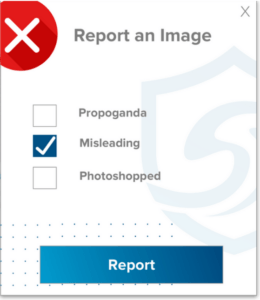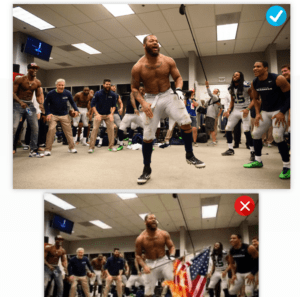I think we can all agree that it is much harder today to know what is true and what isn’t. The amount of fake news, almost true news, and just plain stupid, no-one-cares news has grown unbelievably in the last few years. Couple that with the fact that, regardless of what generation we belong to, we seem to be more willing to believe anything we are told, and you have the recipe for a disaster.
Learning About Fake News
Being a good digital citizen includes being able to tell what is real from what isn’t. You can find ways to help teach students about that in this blog. But there is now another tool that can help as they are learning. And that is SurfSafe.
SurfSafe is a free Chrome add-on that attempts to identify misleading, Photoshop-ed, and fake news throughout the internet. As the company explains,
“At the heart of every fake news story is an image that is likely doctored or taken out of context. SurfSafe uses the news sites you trust, along with face-checking pages and user reports as benchmarks for what images are considered ‘safe.’ It’s simple — just hover over an image and SurfSafe will classify the imge as ‘safe,’ ‘warning,’ or ‘unsafe.’ It will also show you every instance of where the image in question has been seen before. That means that you will be able to see if the context of the image in the article has anything do to with the original instance.”

How SurfSafe Works to Promote Digital Citizenship

It works by having you first tell it what news organizations you trust. Then, it uses those sites as a basis for truth as it evaluates content from other web pages. In addition, you can easily report anything that you see that is not correct through a simple check box.
Here’s an example of what that might look like:

In the Classroom
I would encourage CTOs and Google admins to add the SurfSafe resource to both student and staff browsers. Then, instructional and technology specialists should spend time helping teachers understand how the add-on works, as well as how to best teach students to use it. I envision robust discussions on what news sources are actually reliable today, why the use of fake news and propaganda has grown so much, and how important it is for all of us to rely only on accurate and factual news upon which to base our opinions and actions. SurfSafe provides an excellent tool, as well as a powerful opening to talk about bigger issues we all face.


5 comments
My concern is, what I consider credible news, may be propaganda to others. Defining “real” news unfortunately is a monumental task.
I agree to some extent, Jay. But I think that, at its most basic level, the “news” should be about the facts, the old journalistic tenet of “who, what, when, where, and how” of what is happening. I think the confusion comes in when we look at the “why” or the “what this means,” which may or not be the same for each person reading it. When we have leadership (regardless of political party) that routinely lies about the facts, when other entities or countries try to promote a particular viewpoint of the “news,” when even our own newscasters can’t tell a Photoshopped image from a real one, that’s where the requirement that we teach our students to be discerning citizens who can evaluate the worth of such reporting becomes so incredibly important. And unfortunately, if not us, then who?
Sorry Lori, but based on the simple details provided by the Pew research agency, the sorting process is very subjective. If you pick a news source that has an agenda driven process and they consciously choose to omit news stories then they are not being a true news source because they are reporting by omission as well.
Simply put, using a source that censors the news they dont feel like reporting and then that becomes the comparitive point is creating censorship. This is wrong on every level and I will make sure my children do not allow this app to be placed on their school computers.
This is a slippery slope if the TCEA is supporting this and I do not think censorship is the direction they should be taking.
I wholeheartedly agree with you, David, that censorship of the news is wrong. However, I think that this app does not have to support that, depending on the news sources that you choose as reliable. If something like the BBC News or Bloomberg or Reuters (all news agencies that are supposedly unbiased) is selected as the guide, then the news that appears is more factual and less biased. The bottom line is that this very type of discussion that we are having here needs to be happening in our classrooms today.
Great conversation. One of the ways we can encourage learning around fake news is asking ourselves, “What content curation process do we have in place and how do we model that for our students?” If you’re not familiar with Content Curation, I liken it to panning for gold in a cold mountain stream. I engage in it every day. Wikipedia describes it in this way:
“In simple terms, the process of content curation is the act of sorting through large amounts of content on the web and presenting the best posts in a meaningful and organized way. The process can include sifting, sorting, arranging, and placing found content into specific themes, and then publishing that information.”
As you might imagine, content curation can easily pick up what constitutes fake news and amplify it. Biased information often appears as factual data and we commonly accept it depending on the source. Consider the differing opinions regarding Serena Williams at the recent U.S. Open, the resulting cartoon. How would you handle that bit in your classroom? If you’re smart, you skim the surface or avoid it altogether. Think yourself even-keeled and balanced enough to deal with current news? The March of pitchforks and torches can comes, fast and quick. If you value Fox or MSNBC as news sources, then you must learn to separate out the bias from the facts they present. A T-chart can be one way to accomplish that.
Human beings always introduce bias into their creations, whether it’s a news article or how they curate or present news, information, and “facts.” News can no longer be factual for anyone since we have eroded our belief in authority and objective truth. I’m shocked to be reminded of Allan Bloom’s “The Closing of the American Mind,” a book that I skimmed long ago, shuddering at the assertions made. Now, though, in revisiting the quote that has stayed with me, that “truth is relative,” I stumble on another quote:
“Today we’ve lost the confidence that statements of fact can ever be anything more than just opinions; we no longer know that anything is certain beyond our subjective preferences” (Source: The Death of Truth, https://www.bethinking.org/truth/the-death-of-truth).
A commitment to critical thinking means for me, a willingness to review conflicting, biased information coming from opposing viewpoints. It means panning for nuggets of gold (“fact”) in various pieces, then sharing that after stating my own bias up front. It’s not a new process. Academics, researchers engage in this all the time. But for the masses who sink into stupor in front of their television sets, who wallow in their righteous indignation, made more ignorant in the muck of mad rants of cable news channels, who curate only that which buries them in grime and affirms their biases, prejudices, and hates…well, fake news is gospel in the absence of a more objective deity.
I do not think teachers, those noble hearts whose story TIME magazine is chronicling now (https://www.popsugar.com/moms/Time-Magazine-Teacher-Covers-September-2018-45267662), would risk their livelihoods to stand in the sewers of public opinion and filter the true from the fake, teach fact vs opinion. They would be impeached, cast out for daring to usurp the role of the ignorant parent who clings to their inalienable right to raise a generation steeped in their traditions. Those teachers who dare stand in the ebb and flow of effluence, scrabbling for nuggets of truth, why would they, how could they, champion truth when no one believes in Truth.
Thanks for reading,
Miguel